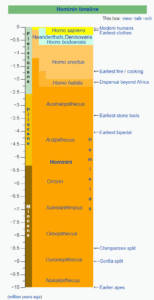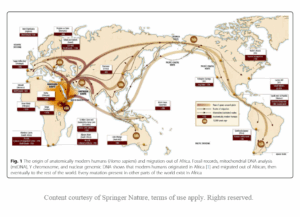Background for Human History

When scientists speak of “humans”, they are sometimes referring to all creatures within the Homo genus. In the graph above, these “humans” include all of the Hominini – the Homo Erectus, the Homo Neanderthals, Homo Denisovians, and Homo Australopithecus. This also includes the Homo Sapiens, which are modern humans that have capabilities for abstract thinking, art, worship, sophisticated language, and so forth. Other scientists confine the use of “human” to just the Homo Sapiens.
From a Biblical perspective, the creation of humans in the image of God in Genesis 1:26-27 and Genesis 2 would seem to correlate to what scientists refer to someone of the genus Homo Sapiens. One can speculate how Adam and Eve were created in relation to Homo Sapiens. The Creator could have breathed His image into an existing species to create a new species of Homo Sapiens. Or the Creator could have taken existing Homo Sapiens and created Adam and Eve from those chosen humans. Or perhaps the Creator took the decayed remains of some Homo Sapiens (“dust of the earth”) and created Adam and Eve from that. Many possibilities exist and more scholarship will be needed to determine which best matches the Bible and scientific findings.
Note that similar to the Genesis account not referring explicitly to dinosaurs, there does not seem to be a reference explicitly to the Homini except for the description of the creation of some Homo Sapiens. Therefore, we focus on Homo Sapiens and their history and environment for the descriptions below.
Human Migration

This map sets guidelines from a Biblical perspective for certain events described in Genesis, namely the Creation of Adam and Eve, the Flood, and the Tower of Babel. Below are some thoughts about the timing of these events.
Creation of Adam and Eve
We would expect the creation of Adam and Eve to have occurred with the creation of Homo Sapiens or perhaps from one of their descendants. Since the Garden of Eden was set in the vicinity of the Tigris and Euphrates rivers, it could be a possibility that Adam and Eve were from the migration out of Africa into the Mesopotamian area (either the southern route or the northern route in the above map). The “Cognitive Revolution” at 70 kya that Dr. Harari writes about in his popular book Sapiens could also suggest an estimated time frame for the creation of Adam and Eve.
The Flood and the Tower of Babel
Genealogy of Genesis 11
If these assumptions are correct, then the genealogy from Shem to Abram in Genesis 11:10-26 would need to have some significant gaps. This genealogy would need to cover from the time of after the flood until the time of Abram. Abram is believed to have lived before 2000 BCE. So, the genealogy of Genesis 11 would need to cover at the minimum from Homo Sapient migration at 60 kya to the birth of Abraham somewhere before 4 kya.
For all of these questions, more research in these areas should be able to better define the prehistoric as well as Biblical events with greater clarity.
